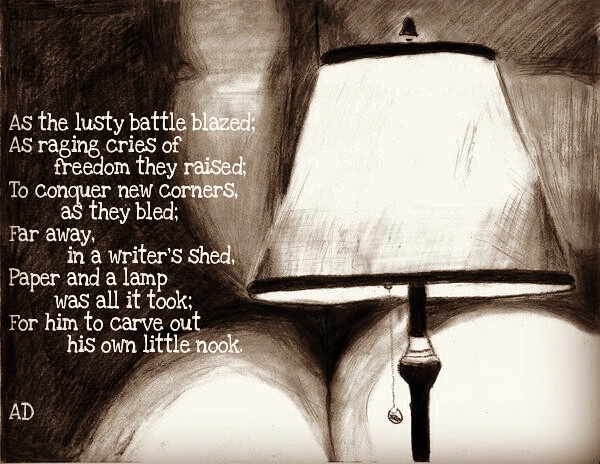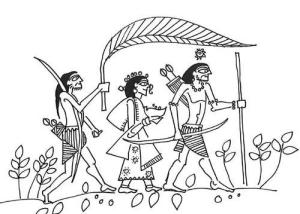About twenty thousand years ago, a certain number of the more erudite amongst the cave dwellers in Altamira, Spain came upon a crossroad. Rife with misunderstandings, the local community of fellow cavemen had degenerated into mere savages. It is at such times that the human mind chances upon ideas which, if not for more uninspired influences, change the course of history leaving posterity to grapple with the repercussions of such a move. The time had come – ideas needed preservation and documentation to avoid confusion. And to this effect, with a bowl of animal fat infused with blood, the world’s very first document was born. Little did he know that more than twenty millennia later, the great Utpal Dutta would recount this to an incredulous Dhritiman (Satyajit Ray’s Agantuk, 1991).

The purest story ever told – The Altamira Bison.
At about the same time across about four thousand kilometers of land and an ocean, in Bhimbetka, India, similar ideas were being put into practice. The French cavemen in Lascaux, not to be left too far behind pitched in as well, soon after.
Posterity has, since then invented the wheel and wings, learnt how to make fire and burn what it creates; learnt how to hunt – animals first, and soon afterwards, its own kin; to invent religion and destroy god. And after all of that, in a comfortable cubicle surrounded by personal memorabilia, a certain engineer rocked in felt chair, frowning. Hamlet would have understood his plight – suffering, as has been well documented, from recurring doubts as to the purpose of his existence. in this case, the well placed engineer – with a plum packet at the end of every month, an assured five year progress plan, a free for all pantry and last but not the least, the very comfortable felt chair – was disgruntled. With everything at his disposal, he wanted more. He wanted satisfaction from what he had made his profession.
Of course you know where this is leading to. “Follow your dreams and be fearless” – a cliché that is as hard to live up to, as it is to not follow at a certain point in life. Does the phrase “Midlife Crisis” ring any bells? Well, the option for the well placed engineer is thus simple – run after the dream of a wish fulfilled or regret, only to run after it later. The well placed engineer, choosing to be foolhardy (Or rather, reckless, immature, and completely shameless as society would have him believe) decides to give it all up. The decision which is only a mere thought, comes without a hiccup. And then gives way to fear. Suddenly, the world which had until then professed the importance of passion for an art, a science, a profession as the single most potent driving force in a human’s life, seems to be in a mood to discourage him; the ones with the “best intentions” are often prone to come close to the man and question his decision and prove, with Machiavellian dexterity, the fault in his best laid plans.
Yesterday, the very same well placed engineer chanced upon a piece on one of those sites that provide unsolicited advice and unsought entertainment. It pointed out the need to distinguish among those who dream and those who live it. Most importantly, it stressed upon the need for both types of people for the world to function. It urged the well placed engineer to look around at overworked colleagues who were satisfied with their harrowing jobs, stressing the need to distinguish between them and himself. They are satisfied with their professions, he is not. so, he needs to make a change. And nothing could be closer to the truth. A person who has gained everything and faces the possibility of losing all, has everything to lose. Human beings live for comfort. And passion does not provide comfort. Well, at least not at the very outset.
The well placed engineer wanted, like the academics-among-cavemen at Lascaux, to tell stories, being completely aware of the results of such a step. And now, as he sits in a classroom staring out, he looks back, not without any misgivings. The well placed days are now long gone. The early morning rush into the seething mass of motorised rodents has been replaced by a later, yet similar circumstance. Grey clouds still do throw a spanner into the works. The streets are just as crowded, the air just as unclean, the people just as obstinate. The Municipal department still boasts an unparalleled track record of failure. The city, remains an oven. But for perhaps the first time in his life, the well placed engineer stares out of the window only to turn his eyes inside. For the first time in his life, does the story of his life share the same fiery blood as that lone bison on the walls of Altamira.
With the fear of the unknown, he gets closure. Now, all he can do, is tell stories.
Leaving comfort is not easy. It’s impossible. Making yourself comfortable. Well, that’s not too hard!

Man finds escape, and reality in stories. The storyteller has to only keep his eyes and ears open; his heart forgiving, and speak on behalf of the ones that need to be spoken of – the characters.
19.007493
72.840389






















